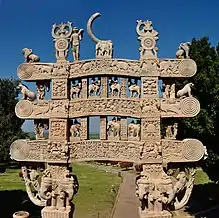Kanva dynasty
The Kanva dynasty or Kanvayana was a Brahmin dynasty[1] that overthrew the Shunga dynasty in parts of eastern and central India, and ruled from 75 BCE to 30 BCE.[2][3]
Kanva dynasty | |||||||||||||
|---|---|---|---|---|---|---|---|---|---|---|---|---|---|
| 75 BCE–30 BCE | |||||||||||||
| Capital | Pataliputra or Vidisha | ||||||||||||
| Common languages | Sanskrit | ||||||||||||
| Religion | Hinduism | ||||||||||||
| Government | monarchy | ||||||||||||
| Maharajadhiraj | |||||||||||||
| History | |||||||||||||
• Established | 75 BCE | ||||||||||||
• Disestablished | 30 BCE | ||||||||||||
| |||||||||||||
Part of a series on the |
|---|
| History of India |
 Satavahana gateway at Sanchi, 1st century CE |
| Outline of South Asian history |
|---|
_without_national_boundaries.svg.png.webp) |
Although the Puranic literature indicates that the Kanva Dynasty ruled from the former capital of the Shunga Empire in Pataliputra, Magadha in Eastern India, their coins are primarily found in and around the region of Vidisha in Central India,[4] which had also been the capital of later Shunga rulers.[5]
The Kanva dynasty was established by Vasudeva Kanva in 75 BC. Vasudeva was initially a minister of the Shunga Emperor Devabhuti, who then assassinated the former emperor and usurped the throne.[6] The Kanva ruler allowed the kings of the Shunga dynasty to continue to rule in obscurity in a corner of their former dominions. There were four Kanva rulers. According to the Puranas, their dynasty was brought to an end by the Satavahanas.[7][3]
Origin
Vasudeva Kanva killed Devabhuti of Shunga dynasty and established the rule of Kanva dynasty.[8]
Rulers
The first ruler of the Kanva dynasty was Vasudeva after whose Gotra the dynasty was named.[9] He was succeeded by his son Bhumimitra. Coins bearing the legend Bhumimitra have been discovered from Panchala realm. Copper coins with the legend "Kanvasya" have also been found from Vidisha, as well as Kaushambi in the Vatsa realm.[10] Bhumimitra ruled for fourteen years and was later succeeded by his son Narayana. Narayana ruled for twelve years. He was succeeded by his son Susharman who was the last king of the Kanva dynasty.[11][12]
- Vasudeva (c. 75 – c. 66 BCE)
- Bhumimitra (c. 66 – c. 52 BCE)
- Narayana (c. 52 – c. 40 BCE)
- Susarman (c. 40 – c. 30 BCE)
Succession
The last king of Kanva dynasty was killed by Balipuccha, who founded the Andhra dynasty.[8]
Aftermath
The defeat of the Kanva dynasty by the Satavahana dynasty was a localised event in Central India.[13][14] However, numismatic and epigraphic evidence suggests that Magadha itself came under the hegemony of the Mitra dynasty of Kaushambi from the 1st century BCE until the 2nd century CE.[14]
References
Citations
- World history from early times to A D 2000 By B.V.Rao, Sterling Publishers, Page 97
- INDIAN HISTORY by Dr. Sanjeevkumar Tandle, Page 150
- Raychaudhuri 2006, p. 333.
- Bhandare, Shailendra. "Numismatics and History: The Maurya-Gupta Interlude in the Gangetic Plain." in Between the Empires: Society in India, 300 to 400, ed. Patrick Olivelle (2006), pp.91–92
- Bhandare (2006), pp.71, 79
- Radhey Shyam Chaurasia. History of Ancient India: Earliest Times to 1000 A. D. Atlantic Publishers & Dist, 2002 - India - 308 pages. p. 132.
- History of Ancient India By Rama Shankar Tripathi, Page 189
- Thapar 2013, p. 296.
- Kumar, Brajmohan. Archaeology of Pataliputra and Nalanda. Ramanand Vidya Bhawan, 1987 - India - 236 pages. p. 26.
- Bajpai (2004), p.38 with footnote 4, and p.173
- optional Indian history ancient India by Pratiyogita Darpan Editorial Team, Page 121 (The Kanvas)
- World Monarchies and Dynasties By John Middleton, Routledge Publishers, Page 486 (Kanva Dynasty)
- Bhandare (2006), pp.91–92
- K. D. Bajpai (October 2004). Indian Numismatic Studies. Abhinav Publications. pp. 38–39. ISBN 978-81-7017-035-8.
Sources
- Raychaudhuri, Hemchandra (2006), Political History of Ancient India, Cosmo Publications, ISBN 81-307-0291-6
- Thapar, Romila (2013), The Past Before Us, Harvard University Press, ISBN 978-0-674-72651-2
| Preceded by Shunga dynasty |
Magadha dynasties | Succeeded by Satavahana |